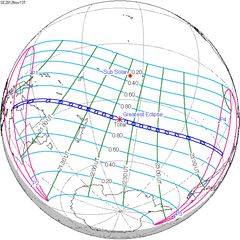November 2003 lunar eclipse
| Total Lunar Eclipse 8–9 November 2003 | |
|---|---|
 Totality from Minneapolis, 1:16 UTC | |
 The moon's path through the Earth's shadow | |
| Series (and member) | 126 (45 of 72) |
| Gamma | -0.4319 |
| Magnitude | 1.0178 |
| Duration (hr:mn:sc) | |
| Totality | 21:58 |
| Partial | 3:31:25 |
| Penumbral | 6:03:09 |
| Contacts (UTC) | |
| P1 | 22:16:59 (Nov 8) |
| U1 | 23:32:50 (Nov 8) |
| U2 | 1:07:34 |
| Greatest | 1:18:34 |
| U3 | 1:29:32 |
| U4 | 3:04:15 |
| P4 | 4:20:08 |
 The moon's hourly motion across the Earth's shadow in the constellation of Aries. | |
A total lunar eclipse took place on Sunday 9 November 2003, the second of two total lunar eclipses in 2003, the first being on 16 May 2003. It is the first total lunar eclipse of 21st century which happened on a micromoon day. The Moon barely edged into total eclipse for 21 minutes and 58 seconds. With the Moon just 1.78% of its diameter into the Earth's umbral shadow, the Moon may have been quite bright, but even so, this should have been worth seeing. The partial eclipse lasted for 3 hours, 31 minutes and 25 seconds. Occurring only 1.4 days before apogee (Apogee on Monday 10 November 2003), the Moon's apparent diameter was 6.4% smaller than average.
This was the last of 14 total lunar eclipses of Lunar Saros 126, which started on 19 June 1769 and ended on 9 November 2003.
Visibility
[edit]It was completely visible over Americas, Europe, Africa and central Asia, seen rising over the Americas and setting over central Asia.
Photo gallery
[edit]-
Grand Rapids, MI, 0:58 UT
-
Minneapolis, MN, 1:00 UT
-
Oudenaarde, Belgium, 1:08 UT
-
Minneapolis, MN, 1:24 UT
-
Grand Rapids, MI, 2:28 UT
Relation to other lunar eclipses
[edit]This is the first eclipse this season.
Second eclipse this season: 23 November 2003 Total Solar Eclipse
Eclipses of 2003
[edit]- A total lunar eclipse on 16 May.
- An annular solar eclipse (one limit) on 31 May.
- A total lunar eclipse on 9 November.
- A total solar eclipse on 23 November.
Lunar year series
[edit]It is the second of four lunar year cycles, repeating every 354 days.
| Lunar eclipse series sets from 2002–2005 | ||||||||
|---|---|---|---|---|---|---|---|---|
| Descending node | Ascending node | |||||||
| Saros Photo |
Date View |
Type Chart |
Gamma | Saros Photo |
Date View |
Type Chart |
Gamma | |
| 111 | 2002 May 26
|
penumbral
|
1.1759 | 116 | 2002 Nov 20
|
penumbral
|
−1.1127 | |
121
|
2003 May 16
|
total
|
0.4123 | 126
|
2003 Nov 09
|
total
|
−0.4319 | |
131
|
2004 May 04
|
total
|
−0.3132 | 136
|
2004 Oct 28
|
total
|
0.2846 | |
| 141 | 2005 Apr 24
|
penumbral
|
−1.0885 | 146
|
2005 Oct 17
|
partial
|
0.9796 | |
| Last set | 2002 Jun 24 | Last set | 2001 Dec 30 | |||||
| Next set | 2006 Mar 14 | Next set | 2006 Sep 07 | |||||
Saros series
[edit]It is part of saros series 126.
Lunar saros series 126, repeating every 18 years and 11 days, has a total of 70 lunar eclipse events including 14 total lunar eclipses. Solar Saros 133 interleaves with this lunar saros with an event occurring every 9 years 5 days alternating between each saros series.
First penumbral lunar eclipse: 18 July 1228
First partial lunar eclipse: 24 March 1625
First total lunar eclipse: 19 June 1769
First central lunar eclipse: 11 July 1805
Greatest eclipse of the lunar saros 126: 13 August 1859, lasting 106 minutes.
Last central lunar eclipse: 26 September 1931
Last total lunar eclipse: 9 November 2003
Last partial lunar eclipse: 5 June 2346
Last penumbral lunar eclipse: 19 August 2472
1901-2100
Metonic series
[edit]This eclipse is the second of five Metonic cycle lunar eclipses on the same date, 8–9 November, each separated by 19 years:
The Metonic cycle repeats nearly exactly every 19 years and represents a Saros cycle plus one lunar year. Because it occurs on the same calendar date, the Earth's shadow will be in nearly the same location relative to the background stars.
|
|

|

|
Half-Saros cycle
[edit]A lunar eclipse will be preceded and followed by solar eclipses by 9 years and 5.5 days (a half saros).[1] This lunar eclipse is related to two total solar eclipses of Solar Saros 133.
| 3 November 1994 | 13 November 2012 |
|---|---|

|

|
See also
[edit]- List of lunar eclipses and List of 21st-century lunar eclipses
- Solar eclipse of 23 November 2003
- May 2003 lunar eclipse
- May 2004 lunar eclipse
- October 2004 lunar eclipse
References
[edit]- ^ Mathematical Astronomy Morsels, Jean Meeus, p.110, Chapter 18, The half-saros
External links
[edit]- Saros cycle 126
- 2003 Nov 09 chart: Eclipse Predictions by Fred Espenak, NASA/GSFC
- NASA Saros series 126
- Photos: Lunar Eclipse 8 November 2003
- Spaceweather.com: Lunar eclipse gallery Nov 8, 2003









